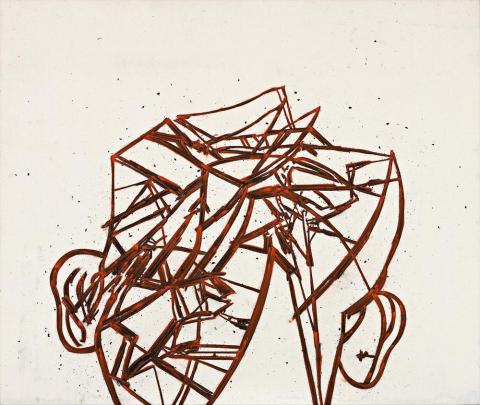HEAD PC028, 2002
TONY BEVAN
synthetic polymer paint and charcoal on canvas
124.0 x 146.0 cm
signed and inscribed twice verso: PCO28 / Bevan
Robert Miller Gallery, New York (label attached verso)
Niagara Galleries, Melbourne
Private collection, Melbourne
Tony Bevan – Recent Works, Niagara Galleries, Melbourne. 4 – 29 May 2004, cat. 7
One of Britain’s most distinctive expressionist painters, Tony Bevan has devoted his career of over forty years to portraiture. Educated at Bradford School of Art (1968 – 71), then in London at Goldsmiths College (1971 – 4) and subsequently at The Slade School of Fine Art (1974 – 6), Bevan received the same artistic training as many other fine British figurative painters. Somewhat younger than these giants of British art (Freud, Bacon, Kitaj and Auerbach), Bevan followed in their footsteps, creating a large body of work centred almost exclusively on an expressive psychoanalytical form of self-portraiture.
Strongly informed by his early investigations into the works of 18th century sculptor Franz Xaver Messerschmidt, Bevan’s paintings and drawings feature tightly cropped and disorientating perspectives of the artist’s own face. Rendered in a restricted chromatic palette and an almost sculptural geometric line, the contours of Bevan’s face appear time and time again on the canvas with a raw power that confronts and challenges the viewer. A former student of Goldsmith’s College, Bevan truly ascribed to their focus on audience-based interpretation and appreciation. This artwork is as much about the artist’s rendition of subject matter through unique materials placed on the canvas in a performative manner (he creates his works on the floor, leaving imprints of his own body weight in the warp and weft of the canvas) as it is about the viewer’s encounter with the portrait. Bevan’s unique composition forces the viewer to look at the image from a certain viewpoint, usually an atypical one. Head PC028, 2002 is a fine example of Bevan’s idiosyncratic style, demonstrating his emphasis not on likeness but rather a raw, radically simplified form of representation. Paul Moorhouse, the curator of Bevan’s 2011 retrospective at the National Portrait Gallery in London remarks ‘in Bevan’s art, self-portraiture has broken with its historic infatuation with recording personal appearance’.1
Bevan’s interaction with primary materials distinguishes his practice from that of his peers. Often mixing his own synthetic paints, Bevan introduces flakes of sand or charcoal into the mixture to build up a raw texture, the grittiness of which directly conveys his subject’s internal monologue and psychological state. Head PC028 is a classic example of this effect, featuring a richly pigmented vermillion synthetic paint, laced with powdered charcoal, set strikingly against a cream ground. The dramatic simplicity of Bevan’s subject matter - a head against a monochrome background, reduced to a maze of jagged ridges assembled architecturally – forces the audience to look past the immediate recognition of a human face, identifying instead with its underlying emotive power. Bevan’s engagement with the social constructs of art, translating his own ideas and physical presence in the creation of his artworks to the viewer, is at odds with the extreme simplification of form that he inflicts on his sitters. It is this tension that endows Bevan’s portraiture with a magnetising presence, and an enduring power to stimulate the eye and mind.
1. Moorhouse, P., ‘His Finite Body: Tony Bevan’s Self-Portraits’, Tony Bevan: Self Portraits, National Portrait Gallery, London, 2011, p. 20
LUCIE REEVES-SMITH
